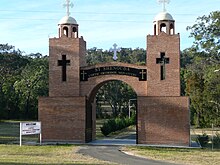Shenoute
[6] There he provided the moral support that Cyril needed to defeat the heresy of Nestorius, Bishop of Constantinople.
On 7 Epip (14 July) 466 CE, following a short illness possibly brought upon by advanced age, Shenoute died in the presence of his monks.
From his uncle, Saint Pigol, Shenoute inherited a monastery based on the Pachomian system of cenobitic monasticism, though more austere and stringent.
This new system had an unusual component: a covenant (Koinē Greek: διαθήκη, romanized: diathēkē) to be recited and adhered to literally by the new novices.
Another feature of Shenoute's monastic system was the requirement for the new novices to live outside the monastery before they were deemed worthy to be consecrated as monks.
Another time he acted to eliminate the cause of grief of the peasants, that the pagan landlords of Paneheou forced them to buy the latter's spoiled wine (Vita #85-6).
On a third occasion he risked his life to successfully ask for the freedom of the captives at Psoi from the hands of the Blemmyes warriors (Vita #89).
In summary, Shenoute fully recognized the misery of his people and emerged as their sincere advocate and popular leader.
He wrote in a style that was essentially his own, with writings based on a careful study of the scholastic rhetoric of his time, which displayed the wide and deep range of knowledge he possessed.
This sets him apart from the Pachomian system that tended to treat religious literature as mere written instructions with no regard to style being given.
The number of legible manuscripts his works survive in are not many, and he wrote in Coptic, which is a language that ceased in use early in the history of Christianity, which added to the obscurity of his writings.
[7] Johannes Leipoldt published several volumes of his works, although he did so without access to all the manuscripts and so did not produce a critical edition.

